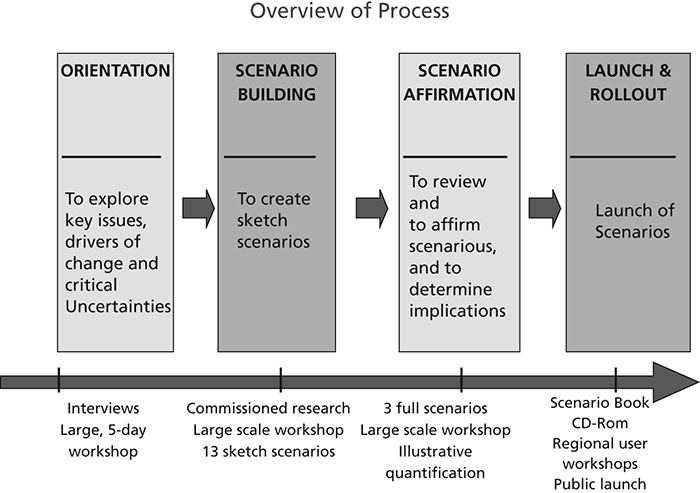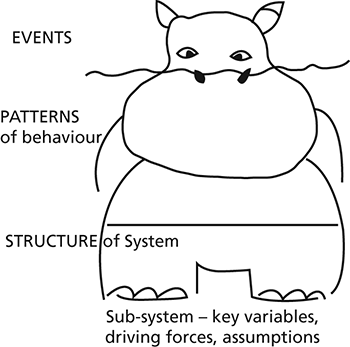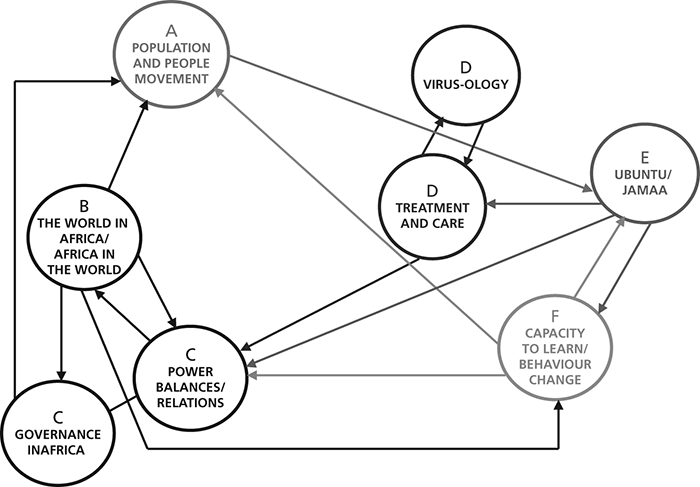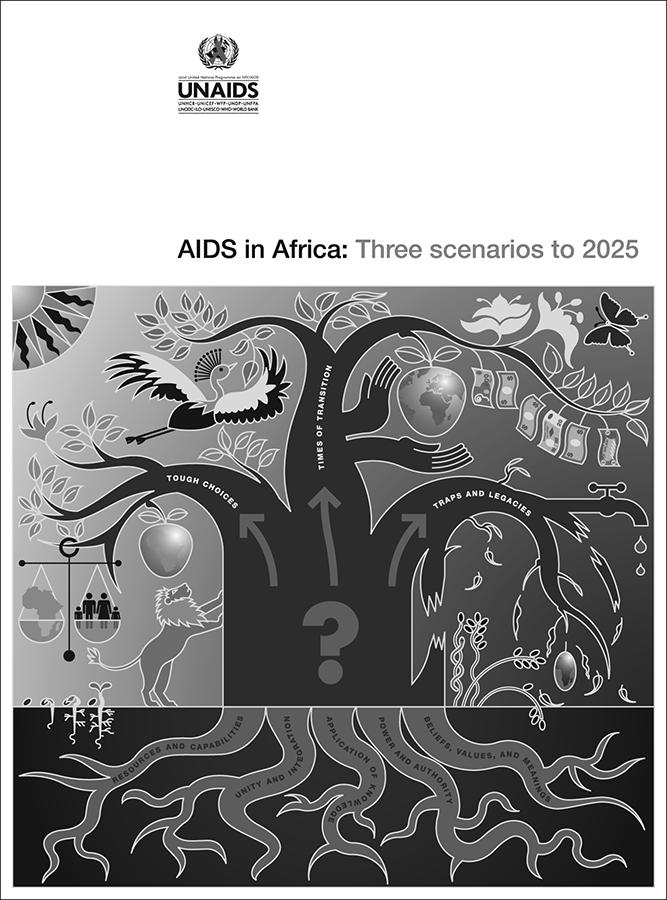■ Appendix D AIDS in Africa Case Study
Angela Wilkinson
Background
Human immunodeficiency virus infection and acquired immune deficiency syndrome (HIV/AIDS) emerged as a global health concern in the late 1980s.
AIDS in Africa: Three Scenarios to 2025 was a collaborative, multi-stakeholder scenario project which took place between 2002 and 2005.1 It was aimed at developing a shared understanding of the possible course of the AIDS epidemic in Africa over the next twenty years across the diverse constituencies involved in a more coordinated response, such as the medical sector, development agencies, central governments, and people living with HIV/AIDS.
In 2001, after more than ten years of collecting data on HIV/AIDS, the Director of the Joint United Nations Programme on HIV/AIDS (UNAIDS), Peter Piot, was looking to move beyond defining the problem of HIV/AIDS to focus the debate on understanding the different patterns of infections that were emerging in different world regions. He also wanted to explore options for a sustained response to the spread of HIV/AIDS, which appeared to depend on a wide set of circumstances. UNAIDS was only one agent in a complex web of actors addressing HIV/AIDS. Supporting an effective response to the epidemic in Africa, and other parts of the world, was not, therefore, a simple case of a complete lack of action, but a challenge of engaging effectively with many organizations, spanning the public, private, and civic sectors.
Following a chance dinner conversation between Piot and the chairman of Shell, Phil Watts, agreement was reached to harness the Shell scenario method and deploy it to support the UNAIDS cause. Shell had a significant business presence in Africa and was concerned about the growing threat of an AIDS epidemic. The company had been developing and using scenarios for decades to appreciate and address new and emerging strategic challenges.
The two organizations entered into a Memorandum of Understanding in which Shell agreed to supply and underwrite its expertise in scenarios. Staff in the two organizations then co-developed a project prospectus, detailing the aims, proposed process, and governance structure for a one-year, multi-stakeholder scenario-based initiative focused on AIDS in Africa (AiA). The prospectus was used in joint fundraising, and another thirteen partners contributed the additional resources required to develop and use a bespoke set of pan-African scenarios.
The project was launched in February 2003 as an undertaking of UNAIDS in partnership with the United Nations Development Programme, World Bank, Economic Commission for Africa, and African Development Bank. It was financed by several development agencies, companies, and foundations:2 DFID, CIDA, DCI, SIDA, USAID, Merck, the Rockefeller Foundation, Pfizer, and the Gates Foundation. Shell International Ltd. provided the project with pro bono expertise in scenario building for the duration of the project, as well as office accommodation for the project team in London.
Scenario project work
The project had four distinct phases and was designed around three large, interactive workshops, with an ongoing element of supporting research, analysis, and numerous smaller meetings (see Figure D1).
Orientation Phase
Interviews were conducted with a range of stakeholders and participants to inform the design and preparation of materials for the first workshop. The initial target of fifty interviews was found to be insufficient in identifying repeating themes, and eventually nearly one hundred interviews were made. These open-ended interviews were synthesized by the core team to develop a “chorus of voices” analysis of the underlying issues, views, and perspectives that different individuals identified about the HIV/AIDS epidemic in Africa and its possible developments over the next twenty years. This analysis provided inputs to the discussions at the first (“orientation”) workshop.
The orientation workshop took place in Addis Ababa, Ethiopia, in May 2003. Seventy participants met over five days to explore critical uncertainties about the future of AIDS in Africa. During this workshop there was a need to adjust the initial workshop design to accommodate a session on “undiscussible issues” perceived to be part of the driving forces of the spread of the epidemic, and of the kind of Africa in which the epidemic was happening (see Box D1). These included: a culture of wife inheritance, taboos on discussing sex/sexuality, pressures from donor countries stifling African choices of development options, traditional medicines, and neocolonialism.

Figure D1. Four phases of the AIDS in Africa project
Box D1 Uncomfortable and Undiscussable
One key aspect of the HIV/AIDS problem was the fact that it dealt with uncomfortable issues which society is unaccustomed to confronting. Because of the manner in which the virus is transmitted, there are trans-cultural forces and cultural taboos which make the problem undiscussable and therefore make it worse. Out of the best of intentions, groups and societies avoid conflict or embarrassment by not talking about HIV/AIDS infection. It can also be undiscussable to talk about why people don’t talk about HIV/AIDS infection. This is a kind of double lock, which prevents deeper and more shared learning. There are also undiscussable issues around Africa’s development and its relationship with the rest of the world.
The workshop participants identified questions requiring further research by the core team. The initial framing of the spread of HIV/AIDS in Africa co-created by the workshop participants revealed the complexity of the situation: this was mapped in a form that included five levels of analysis (individual, community, national, pan-African, international) and six domains of policy (demography, economics, governance, HIV science, African cultures, and diversity).
After the workshop the core team conducted follow-up research on forty-one variables and 205 research questions identified from the workshop discussions: seventy-one research papers were commissioned from a wide set of experts. The findings of these commissioned papers were organized into six theme papers: Capacity to Learn/Behavior Change; Demography and People Movement; Ubunta/Jamaal (work on social capital); Africa in the World/The World in Africa; Virusology, Prevention, and Treatment; and Governance and Key Power Relationships. The six theme papers provided a starting point for recommencing discussions at the next workshop.
Scenario Building Phase
The second large-scale workshop took place over four days in Tunis, Tunisia, in September 2003. Participants engaged in discussions of the linkages among the six themes to develop an initial system mapping of the situation. The map sought to clarify deeper, structural dynamics (see Figures D2 and D3). They then turned their attention to clarifying the research agendas to be addressed by the scenarios. The scenarios explored the question: “In the next twenty years what factors will drive Africa (and the world’s) response to the HIV/AIDS epidemic, and what kind of futures will there be for the next generation?” In seeking an answer to this question, two other questions emerged: “How is the crisis perceived, and by whom?” and “Will there be the incentive and capacity to address this crisis?”
Using these three questions, participants worked with an inductive methodology in parallel breakout groups and used the system map to create possible storylines. They grouped storylines to create sketch (i.e. crude and partial) draft scenarios. The plenary sharing identified thirteen sketch scenarios. Following the workshop the core team worked with the materials developed by the participants and reorganized the sketch scenarios into three more developed scenarios as inputs for the next workshop. Each of the three was given a provisional name.

Figure D2. Graphic used to illustrate search for deeper structural dynamics of AIDS in Africa
(used with permission of author)

Figure D3. Structural dynamics in AIDS in Africa scenario planning case
Scenario Affirmation Phase
A third large-scale workshop took place over four days in Johannesburg, South Africa, in February 2004. The core team’s reorganization of the thirteen sketch scenarios into three more developed scenarios was vigorously contested by the participants, who could neither see nor agree on the logic used by the team in reorganizing their ideas.
A different set of three scenarios was thus restructured by the participants; even so, not everyone agreed with the final choice of three. A subset of participants wanted to progress a fourth scenario called “Mama Africa,” in which the empowerment of women enabled the spread of the virus to be halted. But other participants considered that gender issues needed to be integrated into each of the other three scenarios, rather than considered alone.
Following the workshop, the core team tested and refined the plausibility, relevance, and challenges of the three scenarios in a series of regional workshops. The communicability of the scenarios in relation to different communities was enhanced through the development of illustrative quantification of each scenario by UNAIDS epidemiologists, and this helped to work alongside another form of presenting the scenarios so they could also engage the varied storytelling cultures of Africa. A workshop in Cairo in October 2004 reworked the three scenarios into Sufi tales. A set of African folk tales, commissioned from a published African author, were included in the final report.
A series of private briefings were held for different partners and stakeholders in the run-up to the public presentation of the scenarios. Briefing sessions for staff of UNAIDS, the African Development Bank, SIDA (in Africa), UNDP, Shell International, Merck, Pfizer, CSIS, and the Office of the United States Global Coordinator on AIDS. These briefings provided valuable feedback on how to present the scenarios and also generated interest among key partners.
Public Presentation and Communication
The scenarios were rendered public in a high-level meeting in Addis Ababa in March 2005, attended by numerous African political and religious dignitaries. This signaled the start of a wider roll-out process of engagement and communication.
A book, AIDS in Africa: Three Scenarios to 2025 (see Figure D4), was printed in English, French, and Portuguese. The initial print runs of 10,000 copies in each language were quickly exhausted. The scenarios book was widely distributed, including to UNAIDS offices and partners across the world, including of course the African ones.
A set of PowerPoint presentations which explained the scenarios was produced. These presentations used the visual materials contained in the scenarios book. The presentation materials were also available to download from the UNAIDS website. A CD-ROM containing the scenarios book, PowerPoint presentations, background research papers and report, and supporting audio-visual material, was made widely available. A dedicated UNAIDS webpage was created for the publication event. Most of the project documents and material were made available through the UNAIDS website.

Figure D4. Cover image of the AIDS in Africa scenarios book
The publication of the report received extensive media coverage from all parts of the world, with over 200 articles and placements written about it. Senior staff of UNAIDS gave several interviews to the media.
The AiA scenarios
The three scenarios that were developed and adopted were:
In Tough Choices, antiretroviral therapy has been scaled up, from less than 5 percent treated at the start of the scenario to just over one-third by 2025. The roll out of antiretroviral therapy has increased steadily, reflecting the continued investment in health systems and training, as well as drugs manufacturing capacity within Africa. Compared to Traps and Legacies, an estimated 24 million HIV infections are averted over the next twenty years. Initiatives to support children orphaned by AIDS also increase, but the number of children orphaned by AIDS almost doubles by 2025. This scenario applied the trajectory of the most successful response to date at that time (in Uganda), adjusted for respective national levels of the epidemic.
Traps and Legacies is a scenario where AIDS has depleted resources and weakened infrastructure. As a result, AIDS deepens the traps of poverty, underdevelopment, and inequality. In this scenario, the HIV prevalence across the continent by 2025 remains at around 5 percent of the adult population, with some countries above or below this level. Life expectancy drops across many countries, and the number of people living with HIV in Africa increases considerably. This scenario, in effect, extrapolated then current trends until 2025. HIV prevention efforts are not effectively scaled up. Efforts to roll out antiretroviral therapy continue (over 20 percent of people who needed antiretroviral therapy have access to it), but huge obstacles remain, including a combination of underdeveloped and overwhelmed systems, and escalating costs.
In Times of Transition, AIDS is seen as an exceptional crisis requiring an exceptional response. AIDS is viewed in its broader development context. A series of transitions occurs in the ways Africa and the rest of the world approach health, development, trade, and security. External aid increases considerably and there is sustained social and infrastructural investment. This scenario illustrated what might occur if a comprehensive prevention and treatment response were rolled out across Africa as quickly as possible. In this scenario, Africa’s adult HIV prevalence rate drops considerably, external aid to Africa doubles, and antiretroviral coverage is approximately 70 percent by 2025. Compared to Traps and Legacies, an estimated forty-three million HIV infections are averted by 2025.
Overall, Traps and Legacies showed what might happen if there were inefficient domestic AIDS policies in Africa and volatile or declining external aid; Tough Choices showed what was possible when there were efficient domestic policies but stagnant external aid; and Times of Transition showed what might happen if there were more efficient domestic policies and increased and high-quality external aid. The scenarios suggested that while the worst of the epidemic’s impact was still to come, there was still a great deal that could be done to change the longer-term trajectory of the epidemic and to minimize its impact.
Project results: uses, outcomes, consequences
The AiA scenario initiative invoked the future as a means to establish common ground among the different groups involved in and affected by HIV/AIDS in Africa. It also acted as a way to learn more about current reality and as a platform for mobilizing collective action.
It was the hope of the project initiators, participants, sponsors, and core team that this material would provide an essential starting point, not only for exploring and expanding people’s understanding of the epidemic, but also for sharing that understanding with others and clarifying the role of poverty in the spread of infection within countries and across the continent.
The initial agreement of the project involved a commitment to a formal follow-on phase aimed at using the scenarios. It had been envisaged that UNAIDS would conduct a structured use of the scenarios in a large number of countries. But this follow-up project, which included an element of capacity building on scenario planning, never materialized, although UNAIDS did advocate for national governments to make use of the scenarios.
The scenarios reportedly were used by individual counties and the African Development Bank on a serendipitous basis. The scenarios book was distributed through the UNAIDS offices across the world and one of the most surprising uses of the book was by educators.
Michel Bartok, one of the core team members from the UNAIDS organization, provided the following reflection in 2010, five years after the project concluded:3
The AIDS in Africa Scenarios for the Future project was challenging to UNAIDS. We were not used to thinking that far into the future, and it was not easy to persuade the epidemiologists or those estimating resource needs within UNAIDS to make their estimations that far into the future. However, since the involvement of UNAIDS in the scenarios project there have been a number of changes in perspective which are along the lines suggested by the project’s outcomes. One is a significant emphasis on long term vision in responding to AIDS, including the creation of the aids2031 initiative which is seeking to explicitly bring about such a long term vision. Another is a greater attention to the financing needs and impacts of combined prevention and treatment responses to AIDS, with a focus on 2015 and the Millennium Development Goals. A third is the emphasis on universal approaches to AIDS with the adoption internationally of universal access targets for AIDS prevention, treatment, care and support. Finally, there has been a growing sophistication in addressing the link between poverty, other forms of social inequity and AIDS, including a more confident assertion by UNAIDS that poverty is not a straightforward driver of HIV. None of these responses have been directly or explicitly tied to the results of the scenarios work, but may reflect some of the changes in thinking that the project was intended to stimulate.
More recently, Peter Piot reflected on the project as follows:4
Scenarios for AIDS in Africa was a unique approach to AIDS in Africa. It identified very relevant foresight scenarios, which inspired UNAIDS’ policy development when I was Executive Director. However, the work had little traction at the time, probably because it was clearly ahead of its time. A similar reflection is greatly needed today now that the AIDS response has made major achievements, but remains fragile with an uncertain future in terms of societal and financial sustainability.
Implications
The technical complexities, as well as cultural and political sensitivities of the issues of an international project conducted under the gaze of public scrutiny, required transparent governance mechanisms to be established.
Selection of participants. A three-month search process was needed to identify suitable participants using ten selection criteria: gender, nationality, age, education/profession, connectedness to wider stakeholders, open-mindedness, creativity, ability to leave institutional hat at the door, commitment, and availability. The scenarios were built by a group of over 200 participants; nearly 90 percent came from twenty-four different countries in Africa, and the remaining 10 percent from Europe and North America. They included politicians, musicians, dancers, ministers, heads of AIDS programs, former street children, journalists, religious leaders, doctors and care givers, people living with HIV, scientists, and policymakers.
Governance structure. Oversight of financial expenditures and project management was also provided by an independent international advisory board, comprising representatives of the fifteen sponsors. However, from the very beginning it was made clear that this group would not be able to determine the content of the scenarios. Similarly, while the core team shared the responsibility for the process, the workshop participants took the lead in the shaping of the scenario content.
Even so, the challenges of engaging multiple stakeholders with multiple perspectives using scenarios is not without problems, as highlighted in a paper by one of the core team, Pieter Fourie, which outlines a number of key impressions, insights, and lessons learned from this unique scenario building process.
Continuity challenges. The project was initially designed as a one-year project, but slow fundraising, complex stakeholder selection processes, and unpredictable project delays (e.g. rescheduling a key workshop that was planned to take place in Côte d’Ivoire, due to the outbreak of civil war) extended it to nearly three years. In the interim, many key players on the advisory board and within the co-sponsoring organizations moved on to other roles, as is common in the rotation of staff in international organizations. As a result, the project scope and purpose had to be renegotiated on several occasions.